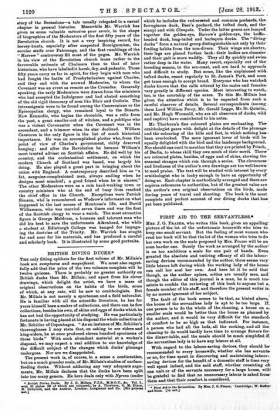BRITISH DIVING DUCKS.* THE only fitting epithets for the first
volume of Mr. Millais's book are sumptuous and magnificent. We must also regret- fully add that the price of the two volumes complete will be twelve guineas. There is probably no greater authority on British ducks than Mr. Millais ; and apart from his clever drawings, which delight the artist, we have a mass of original observations on the habits of the birds, some of which, at any rate, will be new to ornithologists. But Mr. Millais is not merely a sportsman and a field naturalist. He is familiar with all the scientific literature, be has for years himself been a maker of collections, and there can be few collections, besides his own, of skins and eggs of ducks which be has not had the opportunity of studying. He was particularly fortunate in having placed at his disposal the whole collection of Schioler of Copenhagen. " As an instance of Mr. Schibler's thoroughness I may state that, on asking to see eiders and king-eiders, he at once produced eleven hundred specimens of these birds." With such abundant material at a worker's disposal, we may expect a real addition to our knowledge of the difficult subject of the changes which ducks' plumage undergoes. Nor are we disappointed.
The present work is, of course, in a sense a continuation, but on a much grander scale, of Mr. Millais's studies of surface- feeding ducks. Without adducing any very adequate argu. ments, Mr. Millais declares that the ducks have been split into too many genera. He here deals only with Nyroca (under
• British, Divine Ducks. By J. G. F.Z.S., Vol. I., with 32 plates (22 of which are coloured), by A. Thorburn, 0. M. Dixon, H. GrSnvold, sad the Author, London ; Loop:aims and Co. [Six guineas pet.] which he includes the red-crested and common pochards, the ferruginous duck, Baer's pochard, the tufted duck, and the- scaup) and with Clangula. Under the latter genus are lumped together the golden-eye, Barrow's golden-eye, the buffie- headed duck, long-tailed and harlequin ducks. The " diving- ducks " form a natural group distinguishable not only by their- feeding habits from the non-divers. Their wings are shorter,. their legs are placed further back : their bodies are clumsier and their gait is more waddly. They all fly quickly and swim, rather deep in the water. Many resort, especially out of the- breeding season, to the sea-coast, and are hard to approach and difficult to study. But some, like the unpinioned wilts tufted ducks, resort regularly to St. James's Park, and soots get tame enough to accept bread. Everyone who has watches/ ducks knows that the calls uttered by the males and females: vary greatly in different species. Most interesting to watch,. too, is the courtship of the sexes. To this Mr. Millais has given the attention which is to be expected from such a, careful observer of details. Several correspondents (among:• them Lord William Percy, Mr. Gerald Legge, Mr. St. Quintins and Mr. Hugh Wormald, who are all observers of ducks, wild and captive) have contributed to his notes.
Mr. Thorburn's fine coloured plates are enchanting. The, ornithologist gazes with delight at the details of the plumage- and the colouring of the bills and feet, in which nothing has. been overlooked. The mere ignorant lover of birds will be equally delighted with the bird and the landscape background. Nor should one omit to mention that they are printed by Frisch, of Berlin, to whose skill they owe much of their merit. There,' are coloured plates, besides, of eggs and of skins, showing the seasonal changes which run through a series. The cleverness and liveliness of the author's own drawings are too well known• to need praise. The text will be studied with interest by every- ornithologist who is lucky enough to have an opportunity of doing so. Each chapter is methodically arranged and there are copious references to authorities, but of the greatest value are the author's own original observations on the birds, made during years of travel and shooting. The book is the most complete and perfect account of our diving ducks that hats yet been published.


























































 Previous page
Previous page